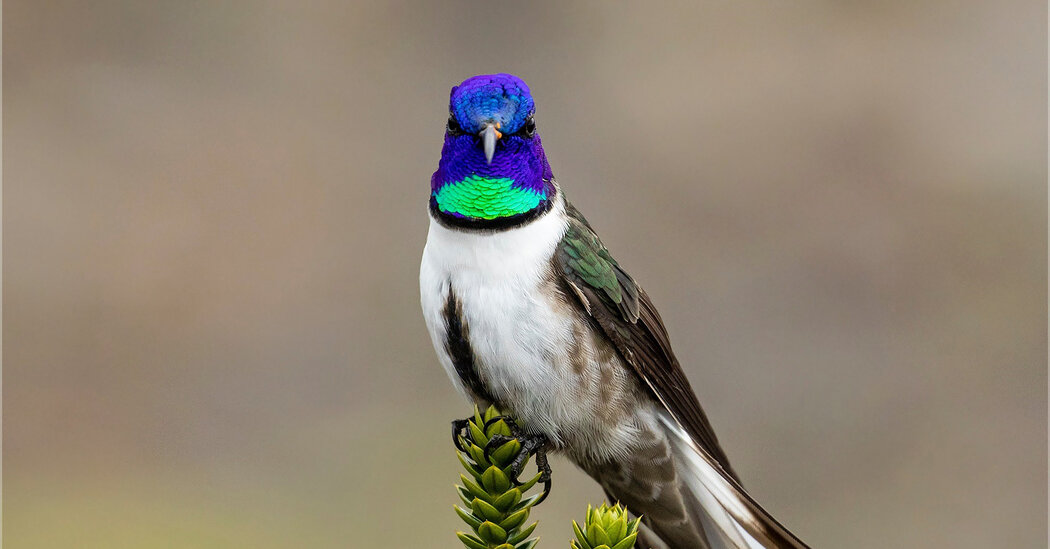
Hummingbirds Living in a Hive Found for the First Time
- Science
- February 14, 2025
- No Comment
- 118
Hummingbirds are tiny and delicate, but don’t be fooled: They are among the most aggressive birds in the avian kingdom. Their territorial fury is especially aimed at other hummingbirds. Competition over a patch of flowers or a mate often results in high-speed aerial chases, divebombing and beak jousting.
So when Gustavo Cañas-Valle, an ornithologist and birding guide, stumbled across a cave full of hummingbirds nesting and roosting together in Ecuador’s High Andes, he could hardly believe it.
“I thought, ‘This looks like a colony,’” Mr. Cañas-Valle said. He added, “They were like bees.”
He documented 23 adult birds and four chicks,all of the subspecies Oreotrochilus chimborazo chimborazo, commonly known as the Chimborazo hillstar.
Mr. Cañas-Valle’s discovery, described in the journal Ornithology in November, may be the first documented example of hummingbirds that nested and roosted communally. It is also notable that he found the birds engaging in both these behaviors in the same space — something that even highly social species from other bird families tend not to do.
Juan Luis Bouzat, an evolutionary geneticist at Bowling Green State University in Ohio and another author of the study who is also Mr. Cañas-Valle’s former graduate adviser, said the finding raised fascinating questions about the role environmental factors can play in driving group living and in promoting the evolution of certain social traits.
Dr. Bouzat and Mr. Cañas-Valle at first hypothesized that harsh environmental conditions along the Chimborazo volcano where they found the nests had forced the birds together. The birds live more than 12,000 feet above sea level on a sparsely vegetated slope where it is hard to come by nectar-providing flowers, water or shelter from freezing temperatures and biting winds.
“Either you aggregate or perish,” Dr. Bouzat said.
But this may not be the full story. Mr. Cañas-Valle explored the region and found six other examples of hummingbirds nesting and roosting together. He and Dr. Bouzat also surveyed concrete drainage pipes scattered around the area. The pipes had similar environmental conditions to the cave but could fit only one or two nests. The researchers found that just 45 percent of the pipes were occupied by nesting females — significantly lower than the frequency expected by chance, according to computer simulations the authors conducted.
There were significantly more nests found in groups, on the other hand, than there would have been if randomly predicted. Of the 74 total nests Mr. Cañas-Valle documented, 82 percent were part of groups. Taken together, these findings implied that the birds were actively choosing group living over nesting alone.
Dr. Bouzat suspects that environmental factors originally caused the birds to aggregate but that once they bunched together, they evolved traits that made them more social, helping them adapt to their environment.
“I was very surprised to read about a truly colonial hummingbird, because most are aggressive and intolerant of others of the same species,” said Scott Robinson, an ornithologist at the Florida Museum of Natural History who was not involved in the work. “No one would have considered a hummingbird a candidate for coloniality.”
Charles Brown, a behavioral ecologist at the University of Tulsa who also was not involved in the research, said he was not convinced, however, that the hummingbirds observed in the study actually qualified as being colonial.
Animals that live in true colonies often behave in ways that benefit their neighbors, Dr. Brown said, such as working together to find food or detect predators. While it was interesting to find hummingbirds in close quarters, “there was no evidence of any social behavior on the part of the animals nesting in these clusters,” he said.
Mr. Cañas-Valle pointed out, however, that he observed the hummingbirds from the cave departing and returning together, suggesting a cohesive social group. “It’s not that each one is doing their own thing,” Dr. Bouzat said.
But the authors agree that more research is needed. They hope to conduct behavioral studies to determine if the hummingbirds are merely tolerating each other or are actively cooperating.
They would also like to conduct surveys for other hummingbird species in similar High Andes environments to see if they are engaging in group living, too. “I’m sure there are other unknown caves in the mountains where hummingbirds live,” Mr. Cañas-Valle said. “I’m expecting to find other species, for sure.”
#Hummingbirds #Living #Hive #Time









